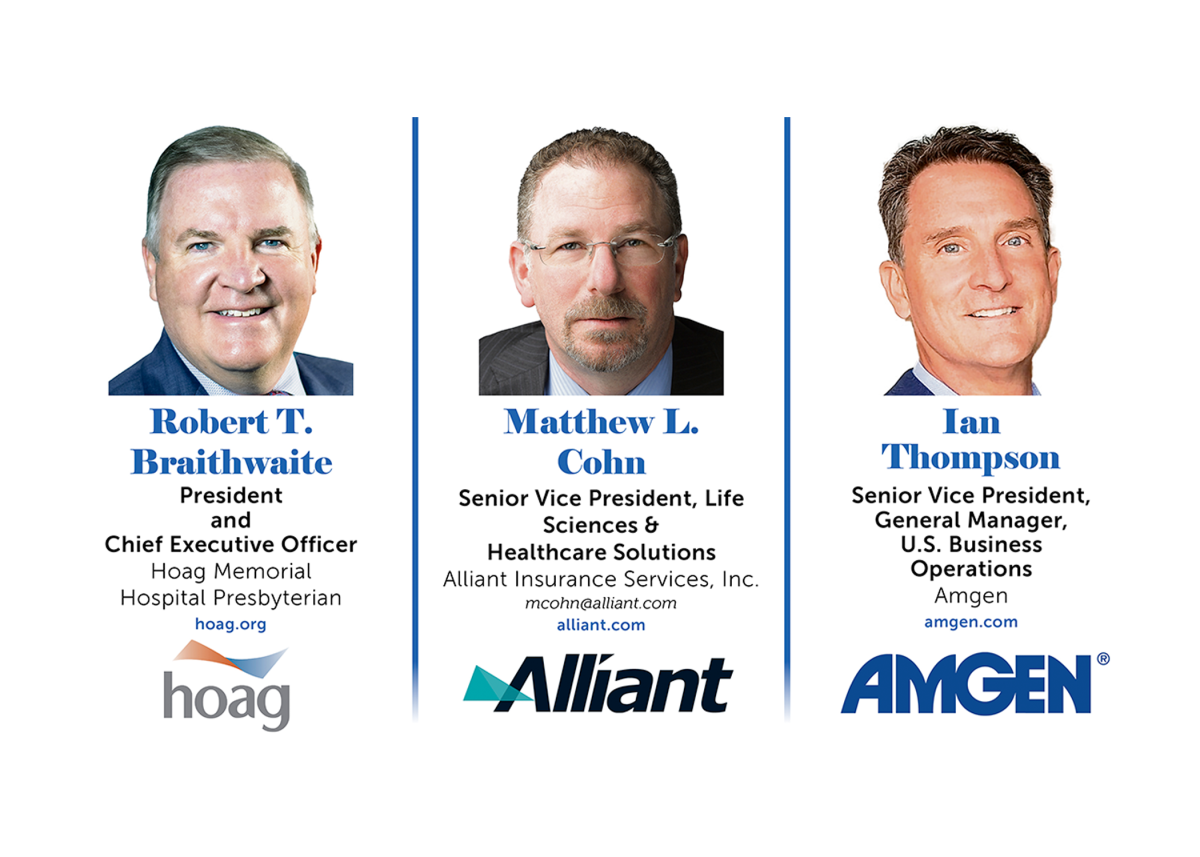Insights on Healthcare, Biotech & Life Sciences from Experts Robert T. Braithwaite, Matthew L. Cohen and Ian Thompson

- Share via
The Healthcare, Biotech & Life Sciences Roundtable panel is produced by the L.A. Times B2B Publishing team in conjunction with Amgen; Alliant Insurance Services, Inc.; and Hoag Memorial Hospital Presbyterian.
Treatment modalities and care best practices aside, the healthcare business sector – perhaps more than any other category of industry – has been forced to reassess, restructure and remodel itself to accommodate the unpredictable and challenging times we have faced over the last two years due to the COVID-19 pandemic.
As businesses continue to edge toward normalcy in Southern California, the decision-makers in the healthcare, biotech and life sciences space are left with a number of challenging questions. Are the changes in operational protocols, regulatory issues, insurance considerations, and financial issues here to stay? Or were the shifts we’ve seen merely temporary?
To take a closer look at the latest concerns and trends in the business of healthcare, biotech and life sciences, we have turned to some of the region’s leading experts, who graciously weighed in for a discussion and shared insights on the state of healthcare in 2022.
Q: What should C-suiters from medical device, pharma and biotech companies be focused on in 2022?

Ian Thompson, Senior Vice President, General Manager, U.S. Business Operations, Amgen: It’s an exciting time to be in biotechnology – a moment when the need for innovative medicines and our ability to innovate are both expanding dramatically. The need for innovative medicines is driven by a rapidly aging population. The population of people in the U.S. aged 65-plus has grown by over a third since 2010. This is important because people over 65 tend to consume 3x as much healthcare as younger people as they navigate the aging process through cardiovascular diseases, osteoporosis, and cancer. Meanwhile, science and tech are converging in ways that accelerate the cadence of innovation in our field. Our business priorities consider the realities of the current environment, including ongoing COVID-related challenges, intensified market share competition, evolving market dynamics and pricing pressure. Despite these challenges, Amgen remains focused on meeting the needs of patients by rapidly innovating to bring new treatments to market.

Matthew L. Cohn, Senior Vice President, Life Sciences & Healthcare Solutions, Alliant Insurance Services, Inc.: As interest rates, inflation, geopolitical issues and public market challenges cause a downward trend in new funding and the cost to service debt increases while private valuations take a beating, controlling expected costs and proactively working to minimize the potential for unexpected underinsured losses should be top of mind. Evaluating property replacement cost values to compensate for inflation and stress testing insurance policy language against a company’s evolving needs to make sure the details are most favorably negotiated to protect the balance sheet from being blindsided by a potentially crippling unexpected underfunded loss are just a couple examples of how we are helping life science C-suiters today. In addition, improving supply chains and dual sourcing critical suppliers should be a priority. When dual sourcing is either unavailable or not cost-effective, insurance coverage for loss of business income due to a covered loss at a third-party facility should be explored.
Q: From your perspective as an expert, how dramatically has the healthcare business and operational landscape changed in the last two years as we’ve all been faced with shifts to overcome the pandemic?

Robert T. Braithwaite, President and Chief Executive Officer, Hoag Memorial Hospital Presbyterian: One of the biggest changes is that patients understandably want access to health care in a variety of ways. Our goal is to connect them with their physicians as quickly and conveniently as possible. One way we’re achieving this is through a new program called “Hoag at Home,” an evolution in our commitment to the community that is in response to Orange County’s changing demographics. The program lets us deliver, in the comfort of residents’ homes, the world-class care that is delivered in Hoag hospitals, physician offices and health centers. We continue to look for and implement new ways to bring high-quality care directly to the communities we serve. This includes the ongoing growth of our health centers and urgent care facilities. Importantly, it also includes offering our nationally recognized, specialized services in areas including cancer, neurosciences, heart and vascular, digestive health and women’s health, in outpatient settings where the community can easily access them.
Thompson: Over the last two years while the landscape has changed, our priority has been continuing to serve patients – those currently on Amgen medicines and those that stand to benefit from potential new medicines in our pipeline. We have collaborated with policymakers and advocacy organizations to address treatment challenges exacerbated by the COVID-19 pandemic, such as the need for virtual and remote care and ensuring a consistent supply of medicines. Our teams have worked to ensure continuity of care and implemented novel solutions, such as alternate sites of care, mobile nurse-administered injections and prescription fills at specialty and retail pharmacies. Amgen is also working to ensure that clinical trials are being implemented consistently with recent guidance from regulators to maintain patient safety and study data integrity.
“Technological advancements are unquestionably revolutionizing the way health care is delivered – and even more important, the way patients recover from procedures and live healthier, happier lives.”
— Robert T. Braithwaite
Q: What process and performance improvement measures should pharmaceutical/life science firms be taking in terms of quality control management/records management and methods of gathering and recording data?
Cohn: We recommend executive teams add cyber security to their list of considerations for record management process improvements. In addition to federal laws such as HIPAA and HITECH in the U.S. and GDPR in the EU, a number of states including California have enacted comprehensive consumer data privacy laws which increase the ramifications should your company suffer a breach of protected information. Today, most cyber insurance underwriters have moved to the opinion that multifactor authentication for all email, remote access and mission-critical systems combined with an Endpoint Detection & Response (or MDR or XDR solution) are among the essential items companies should implement to improve cyber security.
Q: It seems biotech and life sciences are even more important and under the spotlight than ever before. Do you anticipate new surges for investment growth in these sectors?
Thompson: I do see a major investment growth opportunity. We now find ourselves at the beginning of a wave of transformative innovation, building on the technologies developed over the last 30 years. That “low-hanging fruit” has been harvested, and we’re now working to leverage data and technology to discover the next wave of impactful treatments. For example, last year we launched a first-of-its-kind treatment for lung cancer patients with the KRAS G12C mutation, a quest that took 40 years.
Q: How will virtual care and/or telemedicine affect the healthcare landscape moving forward?
Cohn: More physician office visits will be performed digitally, and we expect more Human Clinical Trials to move in this direction as well. We anticipate continued growth in tele mental/behavioral healthcare. Virtual care and telemedicine will continue to expand access to care. This should reduce potential disease/ illness exposure of staff to patients and reduce the cost of personal protective medical equipment. Hospitals that are over capacity and understaffed will be provided potential relief. Patients should see the possibility of financial savings. From an insurance and risk standpoint, it will be even more important to make sure adequate coverage exists for the digital exposures including but not limited to cyber liability, technology E&O, and medical professional liability.
Q: What are some of the most exciting innovations you are seeing in the health sector today?
Braithwaite: Technological advancements are unquestionably revolutionizing the way health care is delivered – and even more important, the way patients recover from procedures and live healthier, happier lives. Speaking from Hoag’s experience, the most exciting and promising developments right now are in the fields of Virtual Reality (VR), Augmented Reality (AR) and Mixed Reality. Our physicians are using VR to assist surgeons with operations, as well as treat patients for pain management, and support with education and mindfulness tools. We believe so strongly in these emerging tools that we recently opened the Hoag Center for Advanced Visualization and Immersive Therapeutics. There, our physicians are researching, developing, and implementing the latest VR/AR technologies to further enhance the patient experience. We’ve pioneered these remarkable technologies since 2015 and believe their role in health care delivery and patient care will only grow more prominent in the years ahead.
“Improving supply chains and dual sourcing critical suppliers should be a priority. When dual sourcing is either unavailable or not cost-effective, insurance coverage for loss of business income due to a covered loss at a third-party facility should be explored.”
— Matthew L. Cohn
Q: What significant operational impacts have biotech, life sciences and medical device organizations shouldered as a result of the pandemic?
Thompson: Over the years we have built a resilient manufacturing and supply chain to ensure our patients suffering from serious illnesses always receive their medicine. We are proud of the fact that since this measure of drug shortages was tracked in 2007, Amgen did not have to report any drug shortages to agencies. This legacy continues despite the increasing frequency of supply chain interruptions such as hurricanes, earthquakes, fires, and now through the COVID-19 pandemic. Following our values, we can confidently say that we do not anticipate any drug shortages or disruptions of our commercial products during these turbulent times.
Q: Are non-urgent sectors of the health industry bouncing back from what may have been a downturn in business for many?
Cohn: Yes, there appears to be a “return to normalcy” in the life science and healthcare sectors. We are seeing a rebound in elective surgeries such as hip and knee replacements, the sale of products that go with those surgeries and we are seeing the resumption of clinical studies that were put on hold due to the pandemic. We expect to see this trend continue.
Q: How can organizations contribute to solving health equity concerns?
Thompson: It’s not enough to develop innovative medicines. Our industry is uniquely positioned to eliminate persistent health disparities and pave the way for true health equity. At Amgen, we lead with science to help transform healthcare, strengthen communities, and demonstrate integrity. For example, our ESG program has always sought to increase diversity in clinical trials. We have recently expanded our efforts to address health equity more holistically throughout the care continuum – from trials to treatment. We see significant opportunities to improve the health of all people through understanding and addressing health disparities present in our communities, particularly in key therapeutic areas such as oncology, cardiovascular disease, and inflammation. By incorporating health equity more fully in our ESG framework, it gives transparency and accountability to our efforts and allows us to share progress toward closing the equity gaps.
Q: How are today’s technological advances being leveraged to improve the health and wellbeing of patients?
Braithwaite: Technology continues to revolutionize the health care industry, from the way clinical trials are conducted to lifesaving surgeries aided by robotic advancements. The challenge for Hoag – and the entire health care industry – is making sure that whatever new technologies we adopt not only make our jobs more efficient but are designed to ensure better long-term outcomes and quality of life for our patients. In other words, technology for technology’s sake won’t cut it. Technology’s litmus test must be its proven ability to enhance patient care. One example of technology that is advancing care at Hoag is the ViewRay MRIdian linear accelerator. Hoag is the first and only center in Orange County to offer this state-of-the-art radiation oncology treatment option that allows clinicians to deliver a higher, potentially more effective, radiation dose while sparing healthy surrounding tissue and decreasing side effects.
Q: Now that we know what we know, what can the healthcare sector do to better prepare for a potential future crisis?
Thompson: At the macro level, we need to redesign healthcare systems so that they are far more resilient to external shocks in the environment. Cost containment is in large part why some healthcare systems faced a crisis when faced with COVID-19 – the systems lacked depth, manageable co-morbidities were not treated and infrastructure such as testing and treating were not scalable. One such co-morbidity, heart disease, is the leading cause of death for men, women, and people of most racial and ethnic groups in the U.S. Substantial progress was made to reduce heart disease mortality rates from about 1970 to 2010, largely due to the introduction of new cardiovascular disease therapies. But now, after decades-long gains, these trend lines have plateaued and have begun reversing. Despite new guidelines and treatment options, access barriers and unfilled prescriptions are linked to heart attack and stroke.
Q: How about the insurance landscape? What changes are you seeing there?
Cohn: While the overall market is showing signs of improvement, life sciences companies will need to “sell” the positives of their risk profiles to insurers in order to obtain the best results. The D&O market is showing signs of improvement with market competition picking up pace in the excess layers. Primary D&O rates have slowed down, and we have started to see some significant premium decreases from extensively marketing D&O renewals on high-quality risks. Life Science Executives should anticipate cyber premium increases and if companies are unable to demonstrate they meet certain security standards the carriers are now viewing as essential, be prepared to have coverage non-renewed or ransomware coverage limitations added. We have been working proactively with our clients to understand how the insurers are adjusting their underwriting of cyber insurance and what cyber security steps to take to best protect their companies and best position their companies for upcoming cyber insurance renewals.
Q: Are wellness programs worthwhile investments for employers?
Braithwaite: Consumers are very interested in preventative care that keeps them from needing to see the doctor. They also now want that care to be delivered with convenience in mind. We recently launched Hoag Compass, an innovative mobile app that enables patients to experience continuous personal care through app-based scheduling and convenient access to primary care physicians, care coordinators, health coaches, exercise specialists, registered dieticians, mindfulness coaches and more. We are changing the traditional trajectory and mindset of health and wellness from one of episodic care – care only when you need it – to a holistic, uninterrupted and ingrained part of a person’s life. With the launch of Hoag Compass, we are looking forward to partnering with patients who want their health and well-being to be integral to their daily lives. This is an opportunity for our patients to help shape how health care is delivered in the future.
“It’s an exciting time to be in biotechnology – a moment when the need for innovative medicines and our ability to innovate are both expanding dramatically.”
— Ian Thompson
Q: For health and life sciences companies, what are the key benefits and challenges to being based in California?
Cohn: Benefits include but are not limited to high population density, diverse talent pool, access to capital and access to top-tier universities and research institutions. Challenges include but are not limited to heavy competition and a unique legal landscape. From an insurance standpoint, increased exposure and cost for wildfire, earthquake, employment practices liability, and other areas of coverage remain challenging for insureds in California. We have seen both homeowners’ insurance carriers and commercial insurers single out both homes and commercial properties as high wildfire risks. In many cases, coverage is being non-renewed or only offered with reduced wildfire limits for higher premiums.
Q: Looking to the future, what health-related trends do you think we can expect to come along within the next five years?
Braithwaite: There are only a handful of hospitals like Hoag that combine a personalized, community-based approach with cutting-edge medicine, renowned specialists and access to clinical trials. This “privademic” approach gives us the best of both worlds – the agility and personalized approach of a private, not-for-profit hospital paired with the world-class innovations of an academic institution. In the next decade, I think this approach will fuel our ability to identify and meet the evolving needs of our community quickly and effectively. We will better be able to draw on our strengths: speed, flexibility, creativity and evidence-based innovation. And when in the best interest of the community, we can partner with other health care providers, payors, employers, companies, and organizations to bring the best care to Orange County.
Thompson: I anticipate that powerful demographic trends, including an aging population and a growing global middle class, will lead to a rise in demand for medicines to treat serious illnesses. We will continue to grapple with the lingering effects of COVID-19, including disruption in the diagnosis/treatment of other diseases. I am also confident that there will be incredible advances in science and technology, which will yield a new wave of medicines to treat and even cure many diseases, and speed time-to-market for new medicines.
